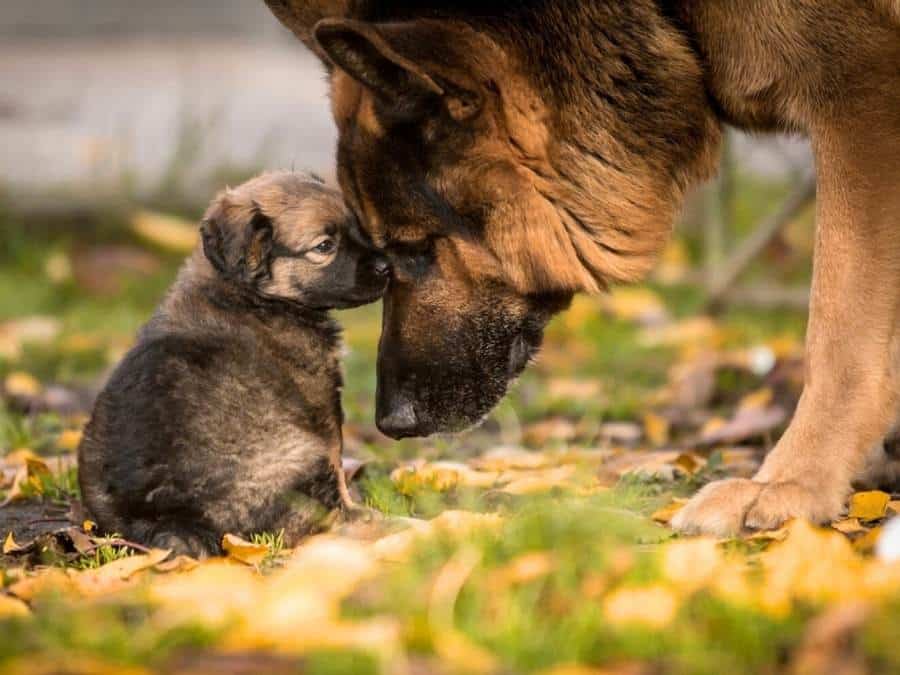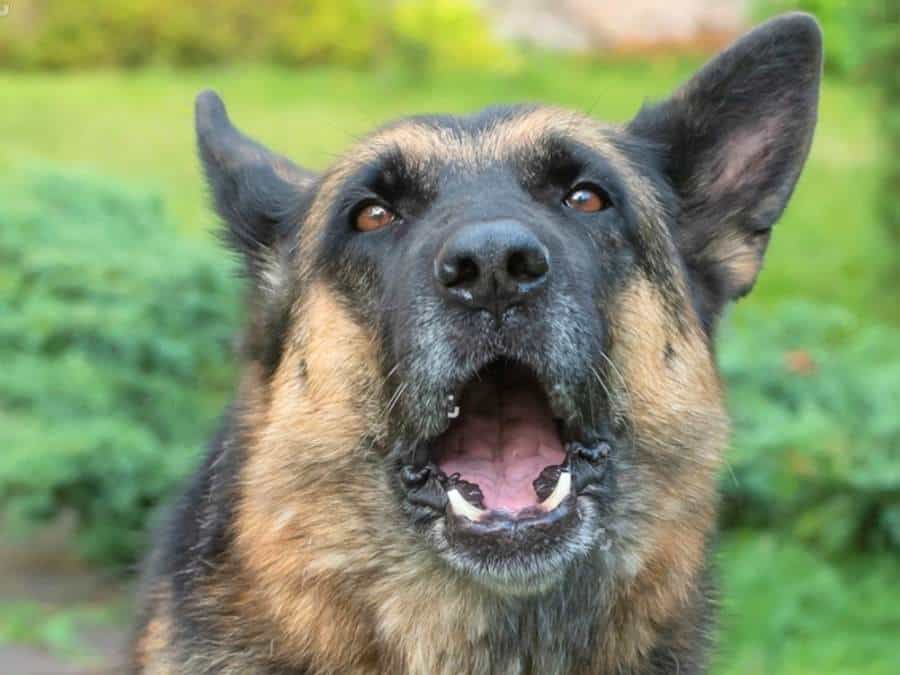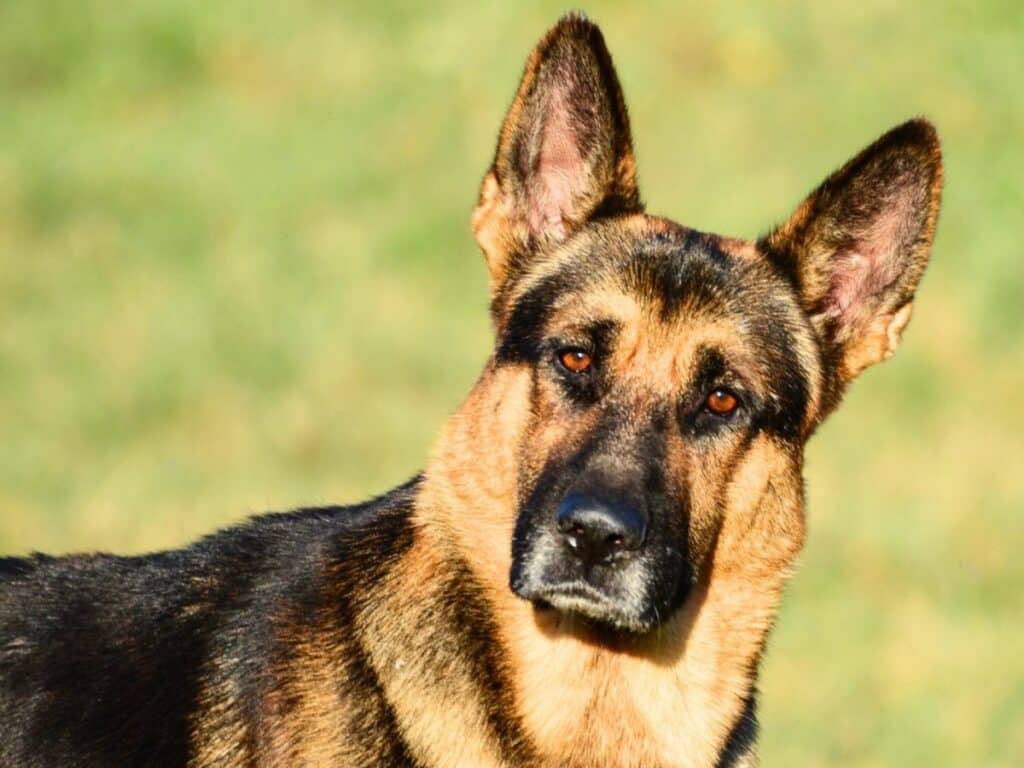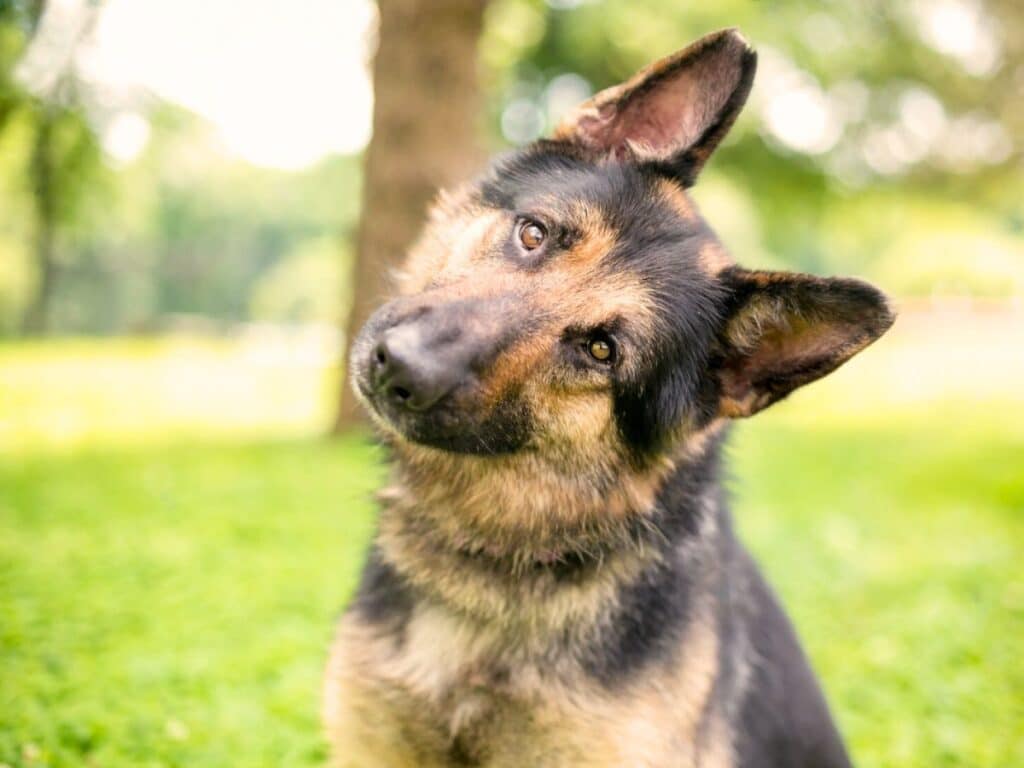Are you planning to bring home a new puppy and are wondering how to introduce them to your German Shepherd? Well, the excitement of welcoming a new addition into your family can be accompanied by challenges, especially when introducing a new pup to an existing dog.
However, with the right approach and early introductions, you can set the stage for a smooth transition and foster a strong foundation between your resident German Shepherd and the new puppy.
In this article, I’ll provide practical tips to ensure a successful introduction process while emphasizing the importance of patience, consistency, and positive reinforcement. So let’s dive in!
How To Introduce Your German Shepherd to Your New Puppy
To introduce your resident German Shepherd to your new puppy, start with controlled meetings in a neutral area, rewarding calm behavior with treats. Gradually decrease the distance between them over several days, while closely monitoring their reactions. Exchange scents between their spaces, supervise interactions and provide separate spaces and positive reinforcement to ensure a smooth transition.
Here’s a step-by-step guide to help you introduce both dogs effectively:
1. Introduce them in neutral territory.
Introduce your new puppy to your resident German Shepherd gradually. According to the American Kennel Club, you should start by choosing a neutral territory where neither dog feels possessive or territorial. This could be a nearby park or an unfamiliar location away from their usual spaces.
By introducing them in neutral territory, you minimize the chances of triggering any territorial behavior from your German Shepherd.
2. Use positive reinforcement techniques during the first meeting.
Rewarding both dogs for calm behavior with treats or praise helps create positive associations.
For example, if they approach each other without any signs of aggression or fear, offer treats as a reward for their good behavior. By reinforcing positive interactions right from the start, you encourage them to associate each other’s presence with pleasant experiences.

3. Allow both dogs to approach each other at their own pace.
Avoid forcing interactions or rushing the process as this can lead to unnecessary stress or potential conflicts.
Give both dogs enough space and time to sniff and observe one another without interference. If either dog shows signs of discomfort or tries to avoid contact, respect their boundaries and allow them more time before trying again.
4. Supervise their interaction but avoid unnecessary interference.
Dogs communicate through body language, and they need the freedom to establish their own boundaries and dynamics.
So, keep a watchful eye on both dogs to ensure their safety, but refrain from intervening unless absolutely necessary.
By allowing them to interact naturally without constant interruption, you give them the opportunity to build trust and develop a healthy relationship.
5. Keep initial interactions short to prevent overwhelming either dog.
When introducing your resident German Shepherd to the new puppy, it’s best to keep the initial interactions short and positive. This prevents either dog from becoming overwhelmed or overly excited, which could lead to undesirable behaviors.
Limiting the length of their first meetings helps maintain control over the situation while preventing exhaustion or stress for both dogs.
ELATED: Are German Shepherds Good Family Dogs?
Positive Signs of a Successful Introduction
When introducing a German Shepherd to a new puppy, it is crucial to pay attention to the signs that indicate good intentions from both dogs. Here are some key indications of good intentions to look out for:

1. Positive body language
When both dogs approach each other with relaxed postures, wagging tails, and soft eyes, it shows they are open to making a new friend.
A relaxed posture indicates that neither dog feels threatened or defensive, creating a welcoming atmosphere for the introduction.
2. Gentle playfulness
Gentle play without excessive roughness or aggression is an indication that both dogs are comfortable with each other’s presence. They may engage in chasing games or gentle wrestling while maintaining appropriate boundaries.
3. Mutual sniffing and exploration
This mutual investigation helps them become familiar with one another’s scents and establish a level of comfort. If both dogs show curiosity without any signs of fear or avoidance, it suggests they are interested in getting acquainted.
4. Play bows or inviting gestures
Play bows are playful gestures where a dog lowers its front end while keeping its rear end up in the air. This gesture is an invitation for play and indicates friendliness.
If both the German Shepherd and the new puppy engage in play bows or exhibit inviting gestures towards each other, it signifies their willingness to bond.
RELATED: German Shepherd Behavior: Their Strange Quirks Explained
5. Calm vocalizations
Dogs communicate through various sounds, including barks, whines, growls, and snarls. In this situation, calm vocalizations such as soft barks or whines are positive signs.
These gentle sounds indicate that both dogs are relaxed and not exhibiting any aggressive tendencies.
By observing these indications of good intentions, you can ensure a harmonious introduction between your German Shepherd and the new puppy. However, it’s also crucial to be aware of warning signs and react accordingly if any unfavorable behavior arises.
RELATED
Signs That Indicate Introduction Is Not Going Well
Recognizing signs that indicate the introduction between your resident German Shepherd and the new puppy is not going well is crucial to ensure the safety and well-being of both dogs. If you observe any of these signs, it’s important to take a step back and reconsider your approach or seek professional help:

1. Aggressive behavior
Growling, snarling, snapping, or lunging towards the other dog are clear signs of aggression. This behavior can escalate quickly and may lead to a dangerous situation.
2. Excessive fear or anxiety
If either dog displays extreme fear or anxiety in the presence of the other, such as cowering, trembling, or trying to escape, the introduction is causing significant stress and discomfort.
3. Prolonged stiffness or tension
If either dog remains stiff, tense, or on high alert throughout the introduction, it suggests they are not comfortable with the situation and may be ready to react defensively.
4. Continuous avoidance
If one dog consistently avoids the other, whether by hiding, turning away, or refusing to interact, it indicates a lack of willingness to engage in a positive way.
5. Excessive mounting or dominance displays
Overly dominant behavior, such as mounting or intense posturing, can lead to confrontations if not addressed appropriately.
6. Excessive barking or growling
Occasional barking or growling might be normal during initial introductions as dogs establish their boundaries. However, if this behavior is incessant and aggressive, it’s a sign of tension.
7. Prolonged body stiffening or raised hackles
Raised hackles (the hair along the back) and sustained stiffness of the body suggest a heightened state of alertness and potential aggression.
8. Persistent resource guarding
If either dog becomes overly possessive of toys, food, or other resources, it can escalate into aggression if not managed properly.
If you observe any of these signs during the introduction process, it’s important to prioritize the safety and well-being of both dogs. Consider consulting a professional dog trainer or behaviorist who can provide guidance tailored to your specific situation.
RELATED:
Tips for Introducing a Puppy to a Resident GSD

1. Allow brief visual contact through baby gates before direct interaction
This allows both dogs to see and observe each other without the risk of any physical harm or aggression. By doing so, they can start getting used to each other’s presence and become familiar with their appearance and body language.
2. Taking them for a walk together
Walking side by side provides an opportunity for the dogs to interact in a neutral environment, which can help promote bonding and positive associations between them.
During the walk, pay attention to their body language and behavior. Ideally, both dogs should appear relaxed and comfortable in each other’s presence. If any signs of tension or aggression arise, it is essential to address the situation calmly and separate the dogs if necessary.
3. Use scent-swapping techniques to familiarize the dogs with each other’s smells
Dogs rely heavily on their sense of smell to gather information about their surroundings and other animals. By allowing the dogs to become familiar with each other’s scents, it can help ease the introduction process.
To do this, you can exchange items that carry the scent of each dog. For instance, you could rub a towel or blanket on one dog and then place it near the other dog’s resting area. This allows them to become acquainted with each other’s smells in a non-threatening way.
4. Avoid favoritism and treat both dogs equally
It’s important to avoid showing favoritism towards either your German Shepherd or the new puppy.
Dogs are perceptive creatures and can sense when one is receiving more attention or care than the other. Treat both dogs equally in terms of affection, attention, and care.
RELATED: German Shepherd Signs of Affection That Will Melt Your Heart
Being Cautious with Possessiveness and Resource Guarding

When introducing a German Shepherd to a new puppy, it is crucial to be mindful of possessive behavior and resource-guarding tendencies. This will help create a harmonious environment for both dogs and ensure their safety. Here are some key points to consider:
1. Watch out for signs of possessive behavior over toys, food, or sleeping areas
German Shepherds can sometimes exhibit possessiveness over their belongings, such as toys, food bowls, or even their favorite sleeping spots. It’s important to carefully observe your dog’s behavior during these situations.
Signs of possessiveness may include growling, snapping, or attempting to guard the resources from the new puppy.
If you notice any of these behaviors, it’s essential not to ignore them. Addressing possessiveness early on can prevent potential conflicts between the two dogs in the future.
2. Separate the resources initially to avoid conflicts
By giving each dog its own space and possessions, you reduce the likelihood of competition or territorial disputes arising between them. This means providing separate food bowls, toys, and designated sleeping areas for each dog.
This separation helps establish boundaries and allows both dogs to feel secure in their own spaces.
3. Implement positive reinforcement training to address possessiveness issues
By using rewards like treats or praise when your German Shepherd demonstrates non-possessive behavior towards shared resources, you encourage them to associate positive experiences with sharing.
For example, if both dogs are calmly playing with toys nearby without showing any signs of aggression or possession over them, reward them with treats or verbal praise. This reinforces the idea that sharing resources leads to positive outcomes.
4. Gradually introduce shared resources under supervision
Start by allowing supervised playtime where both dogs have access to toys but in a controlled manner. This should be done under close supervision to ensure a smooth transition.
Observe their behavior closely and intervene if any possessive tendencies arise. If they continue to interact peacefully, reward them with treats or praise.
5. Refrain from punishing either of the dogs
It is crucial to avoid punishment-based methods when addressing possessiveness in dogs. Punishment can lead to increased anxiety, fear, and even aggression, exacerbating possessive behaviors rather than resolving them.
Challenges in Introducing a New Puppy to Your Resident Dog

Introducing a new puppy to your resident German Shepherd can present several challenges that require careful consideration and management. Here are some common challenges you might encounter:
1. Managing potential Jealousy
It’s essential to remember that dogs, just like humans, can experience feelings of jealousy when they perceive their territory or attention being threatened.
To address this challenge, there are several steps you can take. Firstly, ensure that you continue providing your resident German Shepherd with plenty of love and attention.
Gradually introduce the two dogs in controlled environments. Start with short supervised interactions and gradually increase their time together as they become more comfortable with each other.
2. Differences in energy levels
German Shepherds are known for their high energy levels and often have a more assertive play style compared to puppies.
To ensure a harmonious relationship between both dogs, it’s crucial to provide appropriate outlets for their energy levels.
Engage in regular exercise sessions with your German Shepherd to help burn off excess energy before introducing them to the puppy. This will help reduce any overwhelming excitement during initial interactions.
3. Potential territorial behaviors
Dogs are naturally territorial animals, and bringing a new member into their established space can trigger protective instincts.
To cope with potential territorial behaviors, it’s important to establish clear boundaries and provide each dog with its own safe space. This can be achieved by using baby gates or crates to separate them when necessary.
Gradually allow supervised interactions in neutral areas of the house or outdoors, where neither dog feels a strong sense of ownership.
Conclusion
I trust that the insights I’ve shared have equipped you with the tools needed to introduce your German Shepherd to a new puppy effectively! Remember, introducing two dogs can be a gradual process that requires patience and careful observation. But with consistent effort and positive reinforcement, you can foster a strong bond between your resident German Shepherd and the new puppy.
Frequently Asked Questions (FAQs)
1. How long does it take for my German Shepherd to accept a new puppy?
The time it takes for your German Shepherd to fully accept a new puppy can vary depending on individual personalities and circumstances. It could take anywhere from a few days to several weeks for them to establish a comfortable relationship.
2. What should I do if my German Shepherd shows signs of aggression towards the new puppy?
If your German Shepherd displays signs of aggression towards the new puppy, it’s crucial to address this behavior immediately. Consult with a professional dog trainer or behaviorist who can provide guidance tailored to your specific situation.
3. Can I leave my German Shepherd alone with the new puppy?
It is not recommended to leave your German Shepherd alone with the new puppy until they have established trust and positive interactions consistently over time. Supervision is essential during their initial meetings as it allows you to intervene if any negative behaviors arise.
4. How can I prevent possessiveness and resource guarding between my German Shepherd and the new puppy?
To prevent possessiveness and resource guarding, ensure that both dogs have their own separate resources such as food bowls, toys, and sleeping areas. Implement positive reinforcement training to teach them to share and take turns.
5. Can I introduce my German Shepherd to multiple puppies at once?
Introducing multiple puppies at once can be overwhelming for your German Shepherd. It is recommended to introduce one puppy at a time so that you can focus on building a strong foundation of trust and familiarity between the resident dog and the new addition.




